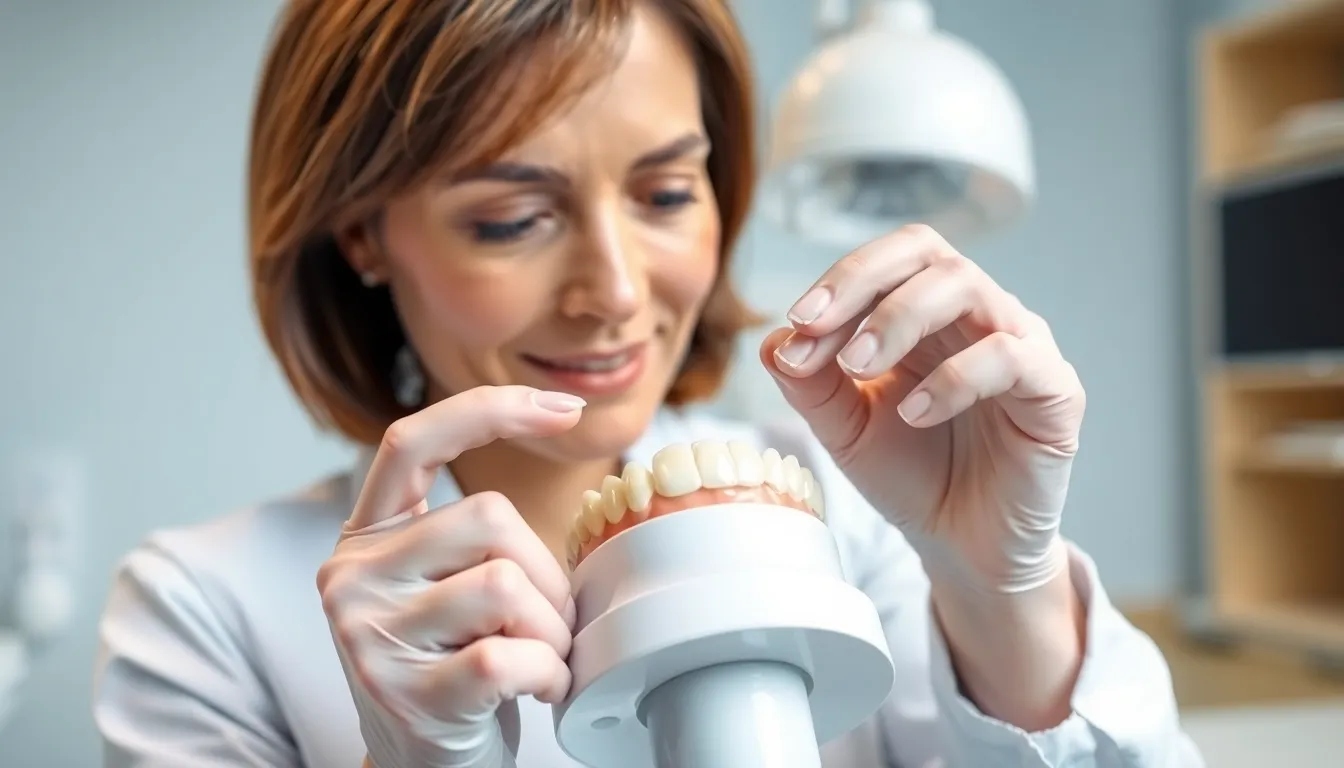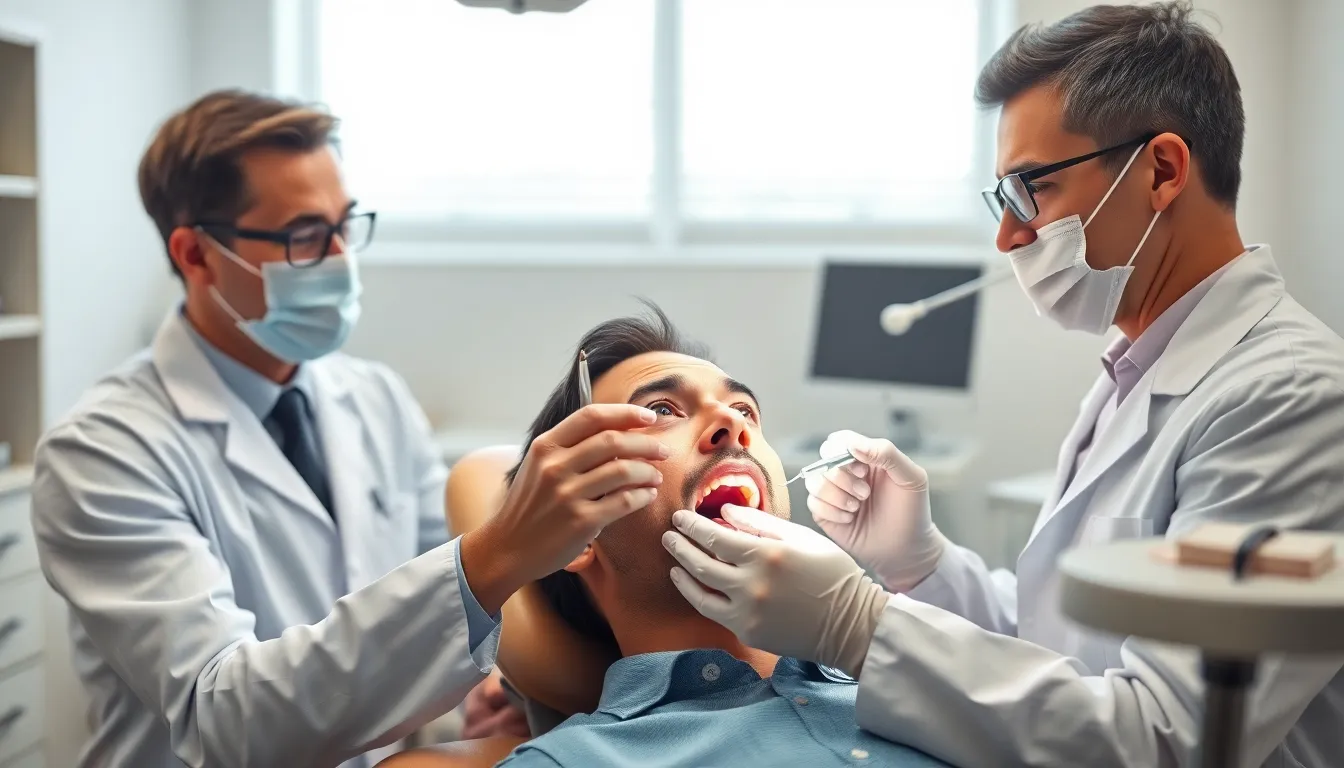Are you struggling with lip support from your dentures? Poor lip support can affect not just your appearance but also your ability to speak and eat comfortably.
When your dentures don’t properly support your lips, you might notice a sunken appearance around your mouth or difficulty pronouncing certain words. This common issue affects many denture wearers, but the good news is that it’s fixable. With the right adjustments and techniques, you’ll be able to restore proper facial contours and regain confidence in your smile.
Understanding Lip Support in Denture Wearers
Lip support refers to how your dentures position your lips in relation to your face, directly impacting your overall facial appearance. When dentures fit correctly, they provide the necessary foundation that prevents your lips from collapsing inward, maintaining natural facial contours. Many denture wearers experience changes in lip support due to the transition from natural teeth to prosthetic replacements.
“I remember Mrs. Johnson coming to our office completely frustrated with her appearance,” recalls Dr. Todd B. Harris. “Her previous dentures made her face look dramatically older because they didn’t provide adequate lip support. After we created properly designed dentures, her family immediately noticed how much younger and more natural she looked.”
Anatomical Factors Affecting Lip Support
Facial muscles interact with your dentures to create proper lip support and maintain facial aesthetics. The orbicularis oris muscle, which encircles your mouth, relies on proper denture positioning to maintain its natural tension and shape. Bone resorption following tooth loss significantly impacts the underlying structure that supports your lips, often resulting in reduced lip fullness over time.
The vestibule area between your lips and gums creates a critical space where dentures must be precisely fitted to provide optimal support. Properly contoured dentures fill this vestibular space appropriately without causing discomfort or unnatural bulging. Age-related changes such as decreased skin elasticity and muscle tone compound lip support challenges, requiring denture adjustments to compensate for these natural developments.
Signs of Poor Lip Support
Facial wrinkles around your mouth often increase when dentures fail to provide adequate lip support, creating an aged appearance that many find distressing. A sunken or “caved-in” look around the mouth area represents one of the most common indicators of insufficient denture lip support. Speech difficulties, particularly with pronunciation of certain sounds like “f” and “v,” frequently stem from improper lip positioning caused by inadequate support from dentures.
Difficulty with certain foods, especially those requiring proper lip closure to prevent spillage, signals potential lip support problems with your dentures. Constant lip adjustment or unconscious lip movements to compensate for poor denture fit indicate your body’s attempt to overcome structural support deficiencies. Changes in your smile line where your upper teeth don’t show properly when smiling suggest that your dentures aren’t correctly positioned to support your lips.
How Denture Design Impacts Facial Aesthetics

Properly designed dentures restore facial contours by filling out the lips and reducing facial folds. They improve jaw function and create a natural smile profile by supporting the facial tissues that have lost their underlying structure. Opening the bite slightly often helps decrease facial wrinkles and enhances lip support for a more youthful appearance.
The Role of the Flange in Lip Support
The denture flange provides essential lip support by gently pushing the lips outward to restore fullness. This extended portion of the denture that sits in the vestibule alongside your lips and cheeks prevents the sunken appearance many denture wearers struggle with. Flange design requires precise balance—overextension causes discomfort and an unnatural protrusion, while insufficient length results in poor support and collapsed facial features. Accurate impression techniques, particularly the piezographic method, ensure your flange contours match the functional movements of your lips and cheeks perfectly. These custom-contoured flanges create optimal support while maintaining comfort during speaking and eating.
Proper Positioning of Anterior Teeth
Anterior teeth positioning critically affects both lip support and overall facial harmony in denture wearers. Your front teeth must align to support your lips’ natural position without causing excessive protrusion or retraction. Functional impression techniques capture lip movement during speech and swallowing, allowing for strategic placement of teeth that maintains proper lip support. The polished surfaces of well-designed dentures help suction and stability, improving natural lip contours. Teeth positioned too far inward create a sunken appearance, while placement too far forward can make lips appear unnaturally full. Dr. Harris often shares that many patients don’t realize how dramatically their facial appearance improves once their anterior teeth are positioned correctly—one patient remarked that proper denture positioning “took years off my face” by restoring the support her natural teeth once provided.
Clinical Assessment for Optimal Lip Support

Clinical assessment forms the foundation for achieving ideal lip support with dentures. A comprehensive evaluation ensures your dentures provide natural facial contours while maintaining comfort and functionality.
Visual Evaluation with Existing Dentures
Your current dentures offer valuable information about lip support adequacy. Dentists examine how your existing prosthetics affect your facial appearance, noting any areas where lips appear sunken or overly projected. This initial assessment helps identify exact issues that need addressing in your new dentures. Dr. Harris often remarks, “I can learn more from five minutes examining a patient’s current dentures than from any textbook—they tell the complete story of what’s working and what isn’t.”
Denture Fit and Border Evaluation
The fit and extension of denture borders directly impact lip support quality. Overly thick or extended labial flanges create excessive pressure on the lips, causing displacement during speaking and eating. Your dentist evaluates how the denture borders interact with facial muscles to ensure they provide adequate support without restricting natural movement. Precision in this assessment prevents common issues like denture slippage or lip strain during daily activities.
Use of Impression Techniques
Advanced impression methods capture the exact contours needed for optimal lip support. Techniques like the copy denture method replicate favorable features from previous dentures that successfully supported your lips. Through accurate impressions and border molding, your dentist creates a denture base that follows your unique oral anatomy. One patient, Sarah, shared how this approach transformed her experience: “After struggling with dentures that made my face look collapsed for years, my new precisely-molded dentures restored my natural smile and confidence.”
Facial Measurements and Landmarks
Facial measurements establish the ideal positioning for denture components that influence lip support. Dentists use reference points like the esthetic plane and natural lip position to determine proper anterior tooth placement. Specialized tools such as the Alma Gauge help measure the precise lip support requirements unique to your facial structure. These measurements ensure your dentures enhance facial harmony by positioning teeth and flanges at optimal distances from facial landmarks.
Speech Pattern Evaluation
Your speech patterns reveal crucial information about denture fit and lip support. By evaluating how you pronounce exact sounds, dentists can identify areas where denture design interferes with natural lip movement. Using tissue conditioners during speech exercises creates a piezograph—a record of soft tissue movements—that guides final adjustments to denture contours. This functional assessment ensures your dentures accommodate both speaking and chewing movements without displacing your lips or affecting pronunciation clarity.
Techniques to Enhance Lip Support in Complete Dentures

Achieving optimal lip support with complete dentures requires exact techniques that focus on both design and fit. Dental professionals employ several methodologies to ensure your dentures provide the facial aesthetics and functionality you need for confidence and comfort.
Customizing Denture Flanges for Individual Needs
The labial flange serves as the critical component for proper lip support in dentures. Accurate extension and contouring of this front edge helps project your lips appropriately, improving your overall facial profile. Dental professionals carefully design the flange thickness to support your lip without creating an unnatural bulge. Border molding techniques capture the ever-changing movements of your lips and cheeks during the impression stage. This process involves tempering impression compound and gently massaging the lower lip to maintain correct vestibule length and ensure proper flange extension. Patients with important ridge resorption often require more attention to flange design to compensate for lost bone structure.
Dr. Todd B. Harris notes, “I’ve worked with many patients who experienced dramatic improvement in their appearance after receiving dentures with properly customized flanges. One gentleman in particular came to me after wearing ill-fitting dentures for years that gave him a perpetually sunken appearance. After we redesigned his dentures with appropriate lip support, his wife commented that he looked 10 years younger.”
Proper Wax Try-In Procedures
Wax try-ins represent a crucial step in ensuring optimal lip support before finalizing your dentures. During this phase, your dentist assesses and adjusts the wax flange thickness and position to determine the ideal lip projection for your facial features. Visual assessment involves observing how your lips rest against the denture while you speak, smile, and make various facial expressions. Your dentist may make real-time adjustments to the wax model based on how your lips interact with the denture structure. These evaluations help customize the denture design specifically to your facial anatomy and movement patterns.
Advanced methods like 3D imaging assist dental professionals in tailoring denture flange design to maintain a natural nasolabial angle and appropriate lip projection. Opening the vertical dimension by adjusting the bite can reduce facial folds and improve jaw function, indirectly supporting your lips by positioning them correctly in relation to your teeth. Individual customization remains essential since lip support requirements vary significantly based on factors like residual ridge condition, soft tissue characteristics, and natural facial proportions.
Adjusting Existing Dentures for Better Lip Support

Existing dentures can often be modified to significantly improve lip support without the need for complete replacement. These adjustments can restore your facial contours and enhance your overall appearance with relatively minor modifications.
Making Modifications to Existing Dentures
Denture adjustments offer an effective way to improve fit and enhance lip support. Adding cushioning material inside the denture ridges fills out the lips better by pressing the denture outward against the lips. Materials like cushion grip provide a temporary solution that increases lip fullness by creating gentle outward pressure from the denture.
Cosmetic denture techniques focus on opening the bite to reduce facial folds and improve jaw function. This approach enhances both lip support and your facial profile by repositioning the denture teeth at an optimal angle. The proper positioning of denture teeth combined with carefully designed polished surfaces creates suction that improves denture stability and lip support.
For superior results, implant-supported dentures provide exceptional lip support. These dentures anchor firmly to dental implants, maintaining bone levels and facial contours over time. This preservation of natural contours helps maintain lip fullness and promotes healthy jaw joint function for years to come.
Dr. Harris notes, “Many of my patients see dramatic improvement in their appearance after simple denture adjustments. One gentleman came in with sunken lips that aged him significantly. After adjusting his denture flange and improving the fit, his family commented that he looked ten years younger.”
When Relines Can Help
Denture relining applies new material to the fitting surface of your denture to improve its adaptation to your gums. This process enhances the connection between denture and tissue, reducing issues like upper lip protrusion caused by poorly fitting dentures. Relines restore more natural lip contours by improving the internal fit of the prosthetic.
Relines prove particularly beneficial when dentures have become loose due to bone or gum changes but the denture base and teeth position remain acceptable. The procedure takes less time than crafting new dentures and offers immediate improvement in both comfort and appearance. Soft relines provide cushioning for sensitive gums while hard relines offer a more permanent solution for dentures that have lost their fit.
One patient shared, “My dentures felt loose and my lips looked thin and wrinkled. After getting a reline, my face looked fuller, and I could smile with confidence again without worrying about my dentures shifting.”
Signs Your Dentures Need Adjustment
Your upper lip sticking out excessively or appearing unnatural indicates poorly fitting dentures that require adjustment. This protrusion creates an artificial appearance that draws unwanted attention to your mouth area.
Loose or unstable dentures cause poor lip support and facial sagging, making you look older than your actual age. The instability prevents proper distribution of pressure against the lips, resulting in a collapsed appearance.
Difficulty chewing or speaking suggests improper bite alignment that affects not only function but also facial aesthetics. These functional problems often correlate with inadequate lip support.
Noticeable facial folds or changes in your facial profile indicate underlying jaw function issues related to denture fit. Deep nasolabial folds (lines from nose to mouth corners) often worsen with poorly fitting dentures.
Gum irritation or soreness results from poor denture fit and requires prompt adjustment to prevent tissue damage. Chronic irritation can lead to inflammation that further compromises denture fit and lip support.
Research shows that simply increasing the lip flange of dentures makes little difference in lip support without addressing overall fit and occlusion. Advanced impression techniques like piezographic impressions record functional movements during setting, achieving natural lip support by preventing over-extension of denture borders and allowing accurate shaping of the lip area.
Communication With Your Prosthodontist

Effective communication with your prosthodontist is essential for achieving optimal lip support with your dentures. Clear discussions about your expectations and concerns help create dentures that look natural and function properly.
What to Discuss During Consultations
During your appointment, share your exact expectations about lip fullness and facial aesthetics. Your prosthodontist needs to understand your desired outcome to design dentures that provide appropriate lip support. Explain any problems with your current dentures, such as insufficient lip support or excessive lip protrusion that makes you feel self-conscious.
Address questions about impression techniques that can capture your natural lip positions for more accurate results. Many patients find that functional impression methods like the piezographic technique lead to significantly better outcomes, as these capture how your mouth moves during speaking and swallowing.
Inquire about implant-supported denture options, which provide superior long-term support by preserving bone structure and maintaining facial contours. Dr. Harris notes, “I’ve seen remarkable transformations in patients who switched to implant-supported dentures—their facial profile remained more youthful because the implants prevented the bone resorption that typically causes a sunken appearance.”
Discuss potential bite adjustments that could improve both function and aesthetics. Opening the bite slightly often decreases facial wrinkles around the mouth and enhances overall lip support. Ask about relining possibilities for existing dentures if complete replacement isn’t immediately feasible.
Bring photos of yourself before tooth loss if available, as these provide valuable reference points for restoring your natural facial appearance. Your prosthodontist can use these images to better understand your unique facial structure and design dentures that complement your features appropriately.
Living With Your New Dentures
Adjusting to new dentures takes time and patience as your mouth adapts to these dental appliances. Your comfort level will increase gradually as you become accustomed to speaking, eating, and smiling with your dentures.
Adaptation Period and Expectations
Your body needs time to coordinate muscle movements with your new dentures, particularly about lip support. Most patients experience an initial adjustment period of 2-4 weeks during which speech patterns may sound different and eating requires practice. Facial muscles gradually adapt to the denture’s contours, allowing your lips to rest more naturally against the denture flanges.
Dr. Harris often tells patients, “The adaptation process is like learning to play a musical instrument—awkward at first, but with practice, it becomes second nature.” According to clinical observations, dentures with properly designed polished surfaces help better suction and stability, which directly enhances natural lip contour over time.
One patient, Margaret, shared her experience: “During my first week with new dentures, my lips felt strangely positioned and my face looked different. By the third week, my muscles adjusted, and my friends commented on how natural my smile appeared.”
You’ll notice improvements in lip support as you continue wearing your dentures. Properly designed dentures fill out facial contours, reducing the appearance of wrinkles and providing that crucial support to prevent a sunken appearance. The piezographic impression technique used by many prosthodontists captures the ever-changing movements of your lips during speaking and swallowing, creating dentures that work harmoniously with your natural facial movements.
For optimal adaptation, wear your dentures consistently throughout the day, removing them only at night to give your tissues rest. Practice speaking aloud and gradually introduce different food textures as your confidence increases. Remember that implant-supported dentures typically provide superior stability and maintain facial contours better than traditional dentures, potentially shortening the adaptation period for lip support.
Conclusion
Achieving proper lip support with your dentures isn’t just about aesthetics—it’s essential for comfort speech and confidence. With the right denture design customized flanges and precise positioning of anterior teeth you can restore your natural facial contours and youthful appearance.
Don’t hesitate to communicate your concerns to your prosthodontist whether you’re getting new dentures or need adjustments to your existing ones. Remember that adaptation takes time but the results are worth it.
By understanding the importance of lip support and working closely with your dental professional you’ll soon enjoy dentures that not only function well but also help you look and feel your best.
Frequently Asked Questions
What causes poor lip support in denture wearers?
Poor lip support in denture wearers is primarily caused by improperly designed or ill-fitting dentures that fail to provide adequate structure for the lips. Bone resorption following tooth loss, aging facial muscles, and incorrect positioning of anterior teeth can all contribute to this issue. When dentures don’t properly replace the volume once occupied by natural teeth and supporting bone, the lips tend to collapse inward, creating a sunken appearance.
How does poor lip support affect appearance?
Poor lip support creates a sunken, aged appearance characterized by increased facial wrinkles, thin-looking lips, and pronounced nasolabial folds (smile lines). The corners of the mouth may droop, and the entire lower third of the face may appear collapsed. This often results in what’s commonly called a “denture look” where the person appears older than their actual age.
Can existing dentures be modified to improve lip support?
Yes, existing dentures can often be modified to improve lip support without complete replacement. Adjustments may include adding material to the labial flange, repositioning anterior teeth, or applying tissue conditioners to enhance fit. Professional relining procedures can also improve adaptation to the gums, which indirectly enhances lip support. However, severe cases may require new dentures for optimal results.
What role does the denture flange play in lip support?
The denture flange, particularly the labial flange, provides essential lip support by gently pushing the lips outward to restore fullness. It acts as a replacement for the natural alveolar ridge that diminishes after tooth loss. Properly designed flanges follow the natural contours of the mouth without creating excessive bulk, providing just enough projection to support the lips while maintaining comfort and natural appearance.
How important is the positioning of anterior teeth for lip support?
The positioning of anterior teeth is critical for proper lip support. When correctly placed, anterior teeth help maintain the natural position of the lips without causing excessive protrusion or retraction. The teeth should be positioned similar to where natural teeth once stood, considering factors like vertical dimension and anterior-posterior placement. Improper positioning can lead to speech difficulties and an unnatural appearance.
What clinical assessments are needed for optimal denture lip support?
Comprehensive clinical assessments include visual evaluation of existing dentures, examination of fit and extension of denture borders, analysis of facial measurements and landmarks, and speech pattern evaluations. Dentists also assess the patient’s facial profile both with and without dentures to determine ideal tooth positioning and flange design. Advanced impression techniques may be used to capture precise measurements of the oral tissues.
How long does it take to adjust to new dentures with improved lip support?
The adjustment period for new dentures typically takes 2-4 weeks. During this time, patients may experience changes in speech patterns and eating habits as facial muscles learn to coordinate with the new appliances. Consistent wearing of the dentures throughout the day accelerates adaptation. Patients generally notice gradual improvement in comfort and function as they become accustomed to the enhanced lip support.
Are implant-supported dentures better for lip support?
Yes, implant-supported dentures generally provide superior lip support compared to conventional dentures. By anchoring to implants in the jawbone, these dentures maintain a more stable position and help prevent bone resorption that contributes to poor lip support. They can be designed with less palatal coverage and more precise flange extensions, allowing for better lip support while maintaining comfort and stability.
What should I communicate to my dentist about lip support concerns?
Communicate specific concerns about your appearance, any discomfort around the lips, and difficulties with speech or eating. Bring photos from before tooth loss to help your dentist understand your natural facial contours. Ask about impression techniques they use, discuss options like implant-supported dentures, and inquire about potential bite adjustments. Clear communication helps ensure your expectations for natural-looking lip support are understood.
What are signs that dentures need adjustment for better lip support?
Signs include excessive upper lip protrusion (fish lip appearance), instability during speech or eating, discomfort around the lips and cheeks, unnatural facial appearance, and difficulty pronouncing certain sounds. Additional indicators include persistent wrinkles around the mouth despite wearing dentures, sunken cheeks, and lips that seem to disappear when closing the mouth. These issues warrant a professional evaluation for potential adjustments.







